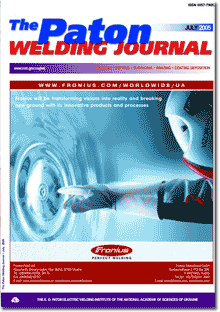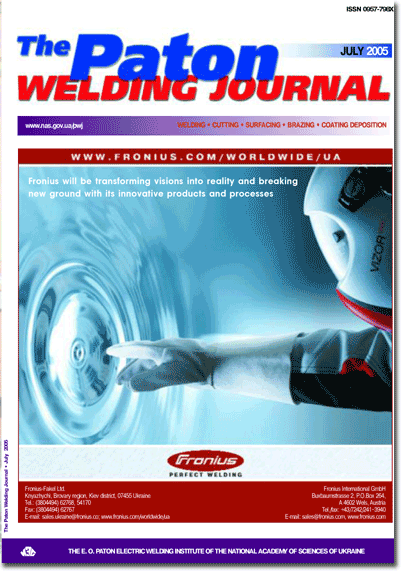

| SCIENTIFIC AND TECHNICAL | |
| Poritsky P.V., Prilutsky V.P. and Zamkov V.N. Contraction of the tungsten cathode welding arc in inert gas mixtures | 2 |
| Effect of physical characteristics of mixtures of inert gases on contraction of the positive arc column was studied. It is shown that variation in the concentration of mixture components has a substantial impact on their thermal-physical properties and general characteristics of electron-atom collisions, which determine electrophysical parameters of the arc under its specific burning conditions. In this connection, contraction of the welding arc burning at tungsten cathode in inert gas mixtures greatly depends upon the proportion of the mixture components. Contraction of the arc discharge in a specific gas mixture was found to be most significant with a gas thermal conductivity dominating in the heat removal process. | |
| Semmler U., Alaluss K. and Matthes K.-J. FE-modelling of the thermometallurgy and stress-distortion behaviour during PTA hardfacing | 8 |
| The paper deals with the process of plasma transferred arc (PTA) deposition of thick hardfacing layers (vanadium-based alloys V12 and V18) on the base material (structural steel S355J0). The differences in the thermo-mechanical properties, local thermo-plastic deformations and phase transformations may cause high residual stress and distortion. The transient thermo-elastic-plastic behaviour of the PTA material deposition is investigated by means of the 3D Finite Element Method (FEM). All thermo-mechanical parameters are dependent on the temperature. The simulated results are compared with measurements of temperature distribution and distortions in order to increase the quality of the numerical models. Using the verified and improved FE-models one can study the influence of welding parameters on the deformations and residual stresses with the aim to optimize the weldments. For thick deposit layers the austenite-martensite transformations have a significant influence on the residual stresses and distortions. Technical applications are shown. | |
| Fadeenko Yu.I., Dobrushin L.D. and Illarionov S.Yu. Mechanisms of joint boundary shaping in explosion welding | 13 |
| New classification is proposed for explosion welding conditions and corresponding shapes of joint boundaries, based on the ratio of inertia forces to strength forces within the welded joint formation zone. This ratio can be used to allow for dynamic characteristics of strength of the metal pairs being welded, in optimization of the explosion welding conditions and shapes of the resulting joint boundaries. | |
| Borisov Yu.S., Zatserkovny A.S. and Krivtsun I.V. Peculiarities of heat exchange between ionised gas and evaporating particle in plasma spraying | 16 |
| Procedure is suggested for calculation of plasma ion and electron energy flows onto the surface of a dispersed material particle in the atmospheric-pressure inert-gas plasma, as well as energy losses for evaporation of the particle material. | |
| Dmitrik V.V. and Konyk A.I. On concept of pore initiation in welded joints under low-temperature creep | 24 |
| It has been found that initiation of pores in welded joints of heat-resistant pearlitic steels and their initial evolution under conditions of low-temperature service creep is mostly of a diffusion character, while their further development is of a dislocation character. | |
| Rymar S.V. Optimization of a transformer with developed yoke magnetic stray fluxes | 27 |
| A procedure is described for optimization of a single-phase transformer with developed magnetic stray fluxes, which uses an upgraded method of stray inductance calculation. | |
| INDUSTRIAL | |
| Blashchuk V.E. Zirconium: alloys, welding, application (Review) | 31 |
| The paper describes the advantages of zirconium and its alloys compared to other structural materials, methods of their production and application in industry, as well as welding features. Applications of zirconium and its alloys, as well as prospects for their use are mentioned. | |
| Voropaj N.M., Ilyushenko V.M. and Mishenkov V.A. Technological capabilities of the processes of gas-shielded pulsed twin-arc welding (Review) | 38 |
| Pulsed twin-arc welding features separate feed of current pulses to electrically insulated consumable electrodes, the arcs of which form a common weld pool. This results in a relatively high (up to 30 kg/h) coefficient of electrode wire melting, high (up to 120 m/h) welding speed, and favourable butt and fillet weld formation. Prospects for further development of the tandem-arc welding processes are outlined. | |
| Tararychkin I.A. Features of assembly and multipass welding of circumferential butt joints on thick-walled shells | 42 |
| Considered are the features of systematic deviations of groove geometry in case of errors of assembly for welding of circumferential butt joints on thick-walled shells. It is proposed to compensate for deviations observed around the butt perimeter by a programmed change of the electrode wire feed rate in multipass welding. Regularities of variation of the wire feed rate for different types of joints are established. | |
| Zhadkevich A.M. Light-beam welding and brazing (Review) | 48 |
| Retrospective analysis of development of the light-beam heating method is given. The leading role of Russian scientists in formation of this area is highlighted. It is noted that the light-beam heating method can be applied for welding and brazing of various materials, as well as for heat treatment of parts. Advantages of welding using the light beam are given in comparison with those of arc welding. | |
| BRIEF INFORMATION | |
| Ryzhov R.N. Application of combined electromagnetic actions for improving the quality of welds in welding with non-consumable electrode | 52 |
| Experiments were the basis to conduct comparative analysis of the effectiveness of application of an electromagnetic impact with a pulsed axial and combined magnetic field to control the parameters of weld formation and solidification. | |
| Gnatenko M.F. Improvement of the technology of heat treatment of coated welding electrodes | 54 |
| The paper deals with the equipment and technology development trends for optimizing the heat treatment of quality electrodes aimed at improvement of drying properties of the coating. | |
| Thesis for a doctor's degree | 56 |
| NEWS | 57 |
| Developed at PWI | 23 51 55 |
(You are viewing the simplified file contents)
The cost of subscription/purchase order journals or individual articles
| Journal/Currency | Annual Set | 1 issue printed |
1 issue |
one article |
| TPWJ/USD | 384 $ | 32 $ | 26 $ | 13 $ |
| TPWJ/EUR | 348 € | 29 € | 24 € | 12 € |
| TPWJ/UAH | 7200 UAH | 600 UAH | 600 UAH | 280 UAH |
| AS/UAH | 1800 UAH | 300 UAH | 300 UAH | 150 UAH |
| AS/USD | 192 $ | 32 $ | 26 $ | 13 $ |
| AS/EUR | 180 € | 30 € | 25 € | 12 € |
| SEM/UAH | 1200 UAH | 300 UAH | 300 UAH | 150 UAH |
| SEM/USD | 128 $ | 32 $ | 26 $ | 13 $ |
| SEM/EUR | 120 € | 30 € | 25 € | 12 € |
| TDNK/UAH | 1200 UAH | 300 UAH | 300 UAH | 150 UAH |
| TDNK/USD | 128 $ | 32 $ | 26 $ | 13 $ |
| TDNK/EUR | 120 € | 30 € | 25 € | 15 € |
AS = «Automatic Welding» - 6 issues per year;
TPWJ = «PATON WELDING JOURNAL» - 12 issues per year;
SEM = «Electrometallurgy Today» - 4 issues per year;
TDNK = «Technical Diagnostics and Non-Destructive Testing» - 4 issues per year.


